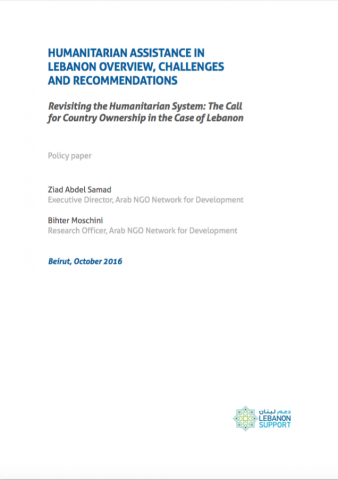Humanitarian Assistance in Lebanon: Overview, Challenges and Recommendations. Revisiting the Humanitarian System: The Call for Country Ownership in the Case of Lebanon.

The 2015 Global Humanitarian Assistance (GHA) Report highlights that in 2013, 147 countries received humanitarian assistance, with countries from the Arab region, particularly those affected by the Syrian crisis, being the highest beneficiaries of aid. More than 3 billion US dollars was directed to Lebanon, Syria and Jordan. This amounts to 15% of the total international humanitarian response and 43% of the funding directed to the top ten recipients. Notably, Lebanon is among the top 10 countries receiving humanitarian assistance. The statistics of the GHA report reveal that overall humanitarian financing has been dominated by international humanitarian agencies and NGOs, which overshadow local and national NGOs; from 2010 to 2014, local and national NGOs received only 1.6% of the total amount given directly to NGOs.
In this context, this policy paper has been developed from a civil society perspective. It looks at the case of humanitarian intervention in Lebanon focusing on the role of different humanitarian actors and examining the partnerships established between international, local and national NGOs. The analysis sheds light on
i) the need to localize humanitarian response through strengthening local capacities to prevent, manage and respond to crises and enhance cooperation with local authorities
ii) the need to establish links between humanitarian intervention and the long-term sustainable development vision and, finally,
iii) the need to ensure genuine implementation of aid effectiveness principles to ensure effective outcomes.
The paper relies on the review of literature (books, articles, statements, position papers and websites) covering humanitarian assistance, development aid, partnership, coordination, collaboration and aid effectiveness. It attempts to answer the following questions: What are the different roles played by diverse actors (local and national NGOs, international NGOs, private sector) in humanitarian assistance? What are the factors that hinder an effective partnership between INGOs, local and national NGOs in humanitarian action in Lebanon? What conditions are needed to ensure the localization of humanitarian response in Lebanon?
Lastly, the paper suggests some recommendations to improve the humanitarian intervention and eradicate the existing aberrations and flaws in the humanitarian system.
*This resource is published in the frame of the call for papers Glocalizing humanitarian interventions in Lebanon: a reflexive look into innovative practices in times of crises developed by Lebanon Support and Amel Association.

